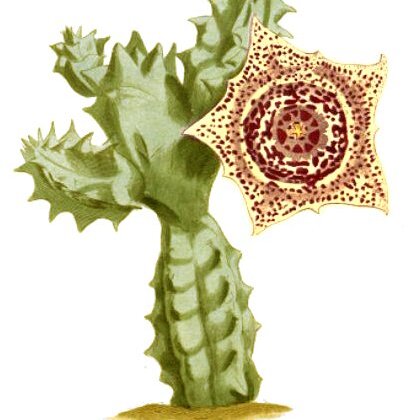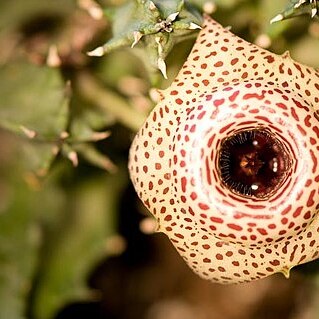Small succulent forming clump 60-200 mm diam. Stems 20-100 mm long, 10-15 mm thick, decumbent, grey-green, sometimes mottled with purple-red; tubercles 4-8 mm long, deltoid, spreading, laterally flattened and joined into 4-5 angles along stem. Inflorescence of 1-3 flowers developing in gradual succession on short peduncle (<5 mm long) with slender lanceolate bracts 2-4 mm long; pedicel 10-30 mm long, 2 mm thick, spreading with upturned apex holding flower facing upwards; sepals 5-7 mm long, 2 mm broad at base, narrowly ovate-acuminate. Corolla (20-)25-70 mm diam., shallowly bowl-shaped to rotate; outside smooth, pale reddish on cream, with 1-3 raised longitudinal veins on each lobe running down towards tube; inside cream with red to maroon spots becoming larger on annulus and coalescing into solid red/maroon in tube (tube sometimes transversely lined or spotted with red or maroon towards base then coalescing around corona), annulus smooth except for some obtuse conical papillae in mouth of tube each bearing erect cylindrical to clavate apical bristle 2.5-4.0 mm long (minute acute papillae on lobes and around corona); tube ±6 mm long, 10 mm broad at mouth, cupular, cylindrical, corolla slightly thickened into shiny annulus around mouth (annulus consisting of slightly thickened tissue pushed forward below bases of lobes); lobes ±8-10 mm long, 15 mm broad at base, erect to spreading or recurved, broadly deltate, acuminate. Corona 6-8 mm tall, 4.5-8.0 mm broad, without basal stipe; outer lobes subquadrate to oblong, emarginate to deeply bifid, spreading on base of tube and partially fused to it, cream to maroon; inner lobes ±4 mm long, adpressed to backs of anthers towards base then connivent-ascending and diverging, below slightly dorsiventrally flattened with slightly inflated dorsal gibbosity at base, above terete and tapering to slender apex, cream blotched with maroon.
More
Like H. barbata but flowers campanulate with shiny, raised annulus, cream-coloured finely spotted with maroon with spots larger and coalescing on annulus, with a few long straight hairs in throat.
Like H. barbata but corolla with a broad, shiny, raised, annular area around mouth of tube, inside cream, with prominent maroon spots, tube ± 6 mm long.


